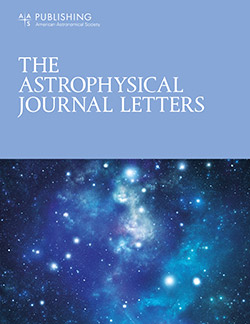Metallicity and Spectral Evolution of WASP 39b: The Limited Role of Hydrodynamic Escape
IF 8.8
1区 物理与天体物理
Q1 ASTRONOMY & ASTROPHYSICS
引用次数: 0
Abstract
Abstract The recent observations on WASP-39 b by JWST have revealed hints of high metallicity within the atmosphere compared to its host star. There are various theories on how these high metallic atmospheres emerge. In this study, we closely investigate the impact of extreme escape in the form of hydrodynamic escape to see its impact on atmospheric metallicity and spectral features such as CH 4 , CO 2 and SO 2 . We perform a grid simulation, with an adapted version of MESA that includes hydrodynamic escape to fully evolve planets with similar masses and radii to the currently observed WASP-39 b estimates. By making use of (photo)chemical kinetics and radiative transfer codes, we evaluate the transmission spectra at various time intervals throughout the simulation. Our results indicate that the massive size of WASP-39 b limits the metal enhancement to a maximum of ∼1.23× the initial metallicity. When incorporating metal drag, this enhancement factor is repressed to an even greater degree, resulting in an enrichment of at most ∼0.4%. As a consequence, when assuming an initial solar metallicity, metal-enriched spectral features like SO 2 are still missing after ∼9 Gyr into the simulation. This paper, thus, demonstrates that hydrodynamic escape cannot be the primary process behind the high metallicity observed in the atmosphere of WASP-39 b, suggesting instead that a metal-enhanced atmosphere was established during its formation.WASP 39b的金属丰度和光谱演化:流体动力学逃逸的有限作用
JWST最近对wasp - 39b的观测揭示了与其主星相比大气中金属丰度较高的迹象。关于这些高金属大气是如何形成的,有各种各样的理论。在这项研究中,我们密切研究了极端逸出以水动力逸出的影响,以了解其对大气金属丰度和光谱特征(如ch4, CO 2和so2)的影响。我们进行了网格模拟,使用MESA的一个改编版本,包括流体动力学逃逸,以完全演化出与目前观测到的wasp - 39b估计的质量和半径相似的行星。通过使用(光)化学动力学和辐射传递代码,我们评估了在整个模拟过程中不同时间间隔的透射光谱。我们的研究结果表明,WASP-39 b的巨大尺寸限制了金属增强,其最大强度为初始金属丰度的1.23倍。当加入金属阻力时,这种增强因子被抑制到更大的程度,导致最多约0.4%的富集。因此,当假设初始太阳金属丰度时,在模拟的~ 9 Gyr之后,仍然缺少像so2这样的金属富集光谱特征。因此,本文证明了流体动力学逃逸不可能是wasp - 39b大气中观察到的高金属丰度背后的主要过程,而是表明在其形成过程中建立了金属增强大气。
本文章由计算机程序翻译,如有差异,请以英文原文为准。
求助全文
约1分钟内获得全文
求助全文
来源期刊

Astrophysical Journal Letters
ASTRONOMY & ASTROPHYSICS-
CiteScore
14.10
自引率
6.30%
发文量
513
审稿时长
2-3 weeks
期刊介绍:
The Astrophysical Journal Letters (ApJL) is widely regarded as the foremost journal for swiftly disseminating groundbreaking astronomical research. It focuses on concise reports that highlight pivotal advancements in the field of astrophysics. By prioritizing timeliness and the generation of immediate interest among researchers, ApJL showcases articles featuring novel discoveries and critical findings that have a profound effect on the scientific community. Moreover, ApJL ensures that published articles are comprehensive in their scope, presenting context that can be readily comprehensible to scientists who may not possess expertise in the specific disciplines covered.
 求助内容:
求助内容: 应助结果提醒方式:
应助结果提醒方式:


